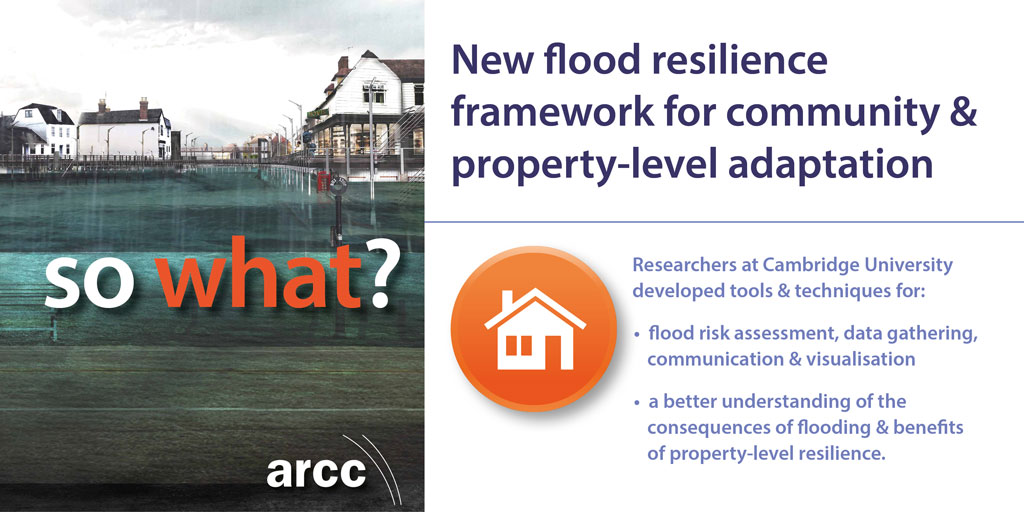In an on-going project, researchers at Cambridge University are developing tools & techniques for flood risk assessment, data gathering, communication & visualisation a better understanding of the consequences of flooding & benefits of property-level resilience.
With an increasing number of properties at risk of flooding, we urgently need to assess the resilience of buildings and consider the consequences and benefits of adaptation. Although efforts are underway to reduce the exposure of at-risk communities, there’s a disjoint between large scale adaptation / alleviation strategies and property-level adaptation.
Without a detailed understanding of individual properties, flood risk thresholds and tipping points, decision-makers at both national and local levels remain unaware of the potential adaptation capacity of communities. The Retrofitting Resilience study and framework address this knowledge gap and can be used to evaluate both the current and future flood resilience of a community.
Research aim:
- Develop new tools & techniques to assess, gather data, communicate & visualise flood risk.
- Understand the tangible & intangible consequences of flood events, & the benefits of property level resilience (PLR).
- Consider the indirect impacts of flooding on; occupancy, accessibility, functionality of services such as waste, power & water, & placemaking.
- Explore the value of using scenario testing in a mixed-method research framework for assessing flood resilience in the built environment.
The process:
- The framework was applied & tested in Yalding in Kent.
- Data on the conditions & consequences of the 2013–14 flood was recorded through surveys, interviews, community engagement workshops, & visualised using 3D digital models, & GIS mapping.
- Information on property details such as house type, construction material, flood hazard, resistance & resilience measures & the resulting consequences were combined with millimetre-accurate threshold data. This allowed us to create a sophisticated model to assess the past, present & future flood resilience of Yalding under current & adapted spatial configurations.
- This was a multi-disciplinary, collaborative project with the Yalding residents, the Environment Agency, architects, engineers & support from the Cabinet Office.
Now what?
Identifying community-level flood resilience helps to increase our understanding of the strengths and weaknesses prevalent in the built environment, and enables us to consider what, where and when adaptation strategies are appropriate.
To encourage community-level adaptation, flood resilience assessments must include thresholds and details of property-level resilience strategies. The scenario-based strategy we used stress-tests the community at a house, village and catchment level, using spatial and visual communication tools to analyse and present the outcomes. This helps to demonstrate the consequences of inaction to key stakeholders, and the severity of threats they may be forced to endure.
Our research found that adapting to lessen flood risk can act as a driver to encourage change and improve the quality of the built environment. Enhancing the flood resilience of communities can help lower the vulnerability of homeowners and properties at risk, reducing the cost, time and trauma of recovery whilst increasing community wellbeing.
Decision & policymakers:
- Recognise the importance of broader assessment of resilience and consider disruption to: access, occupancy, functionality of services – such as waste, power, water – and placemaking.
- Use the framework to assess community resilience and as a tool for communicating the consequences and benefits of adaptation.
- Realise the value of scenario testing and mixed-method research in exploring alternate strategies for adaptation.
- Consider creating areas of special planning exemption in places at significant risk of flooding in order to encourage adaptation.
- Gather detailed threshold data for at-risk communities to enable accurate analysis.
- Currently there are only a few exemplar flood-resilient properties throughout the UK. We urgently need larger scale examples of flood resilient communities.
Next steps:
- Application of the Retrofitting Resilience Framework to larger settlements and within communities that have not previously experienced – but are at risk of – flooding.
- Development of an app to help inform strategic decision-making at different stages of a flood event.
- Promote Yalding in becoming an exemplar of a community-led approach to flood adaptation planning for future towns and villages to follow.



